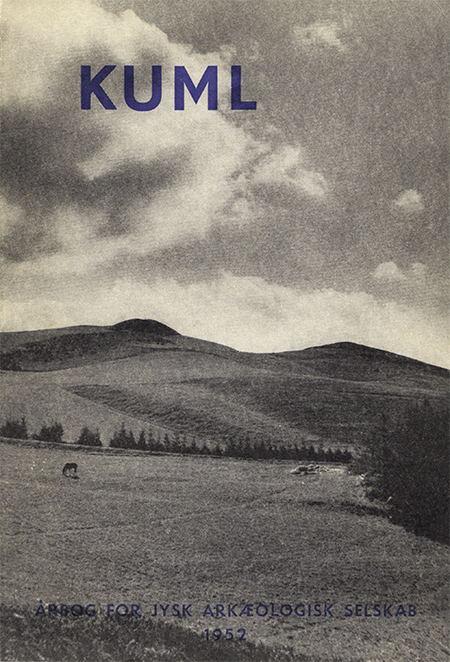Frøya fra Rebild
DOI:
https://doi.org/10.7146/kuml.v2i2.24902Nøgleord:
RebildResumé
Frøya from Rebild
Representation of the human form was so rarely attempted - or at least is so rarely found - in prehistoric Denmark that the report received by Aalborg Historical Museum in July 1946, that a wooden figure of a human being had been found, aroused the wildest of hopes - hopes that perhaps a corner of the veil which the coming of Christianity drew over the beliefs and superstitions of prehistoric times would at last be lifted.
The figure (fig. 1) was found in a little peat-bog of less than an acre in extent, at Rebild Skovhuse, a cleared valley running into the immense Rold Forest in north Jutland. It was of birch and so rotten that it was only the care with which the farmer had taken it up and the equally careful conservation, which lasted three years, that preserved it for our study. It is 1.05 meters tall, formed of the bole of a young tree and only sketchily shaped on the basis of the original tree-form. The figure is clearly that of a woman, the sexual characteristics being particularly emphasized. The arms are not represented, while the legs, probably formed by a fork, had been broken off before the figure was placed in the bog.
Besides the figure was a large piece of woven material. It was worn and patched, and of four-shaft weave most resembling the Iron Age cloth from Borremose. It had perhaps been originally wrapped around the figure. Pollen analysis suggests, with reservations, a dating to the Roman Iron Age.
Only two discoveries have been made in or near Denmark of figures comparable with the female figure from Rebild. In 1888 a male figure was found in Broddenbjærg peat-bog near Viborg (fig. 2). It was fashioned of the fork of a tree, the main trunk forming the head and body and two branches of the fork the legs, while a third branch projecting at an angle formed the phallus, the potency of which was so emphasized that it without doubt forms the raison d'etre of the figure. The statue was found besides a heap of stones and a pottery vessel was placed by its side. It has been dated to the Late Bronze Age but is more probably later.
More recently, at Braak near Eutin in Holstein, two figures, one male and the other female (fig. 3), were found on a little island in a saucer-shaped peatbog together with several superimposed layers of blackened stones, ashes and charcoal.
These discoveries are clearly those of gods and goddesses lying besides their altars. But is it possible for us to give their names? We know from the sagas that in the Viking Period the Scandinavians worshipped, in addition to the warrior Asa-gods, the more peaceful Vana-gods, the spirits of the weather, of land and sea, of the family of Njord. And Tacitus gives us a picture of this Njord, or Nerthus, as a goddess of fertility. Concerning Njord's children, Frøy and Frøya, who were also man and wife, many scandalous verses have survived telling of their sexual adventures, and countless more, now lost, were said by Adam of Bremen to have been sung before the phallic statue of Frøy at Upsala. Clearly a god and a goddess of fertility were worshipped throughout the Iron Age, and until valid counter-arguments are found it may be permitted to call these simple representations by the names of Frøy and Frøya.
Peter Riismøller
Downloads
Publiceret
Citation/Eksport
Nummer
Sektion
Licens
Fra og med årgang 2022 er artikler udgivet i Kuml med en licens fra Creative Commons (CC BY-NC-SA 4.0).
Alle tidligere årgange af tidsskriftet er ikke udgivet med en licens fra Creative Commons.


